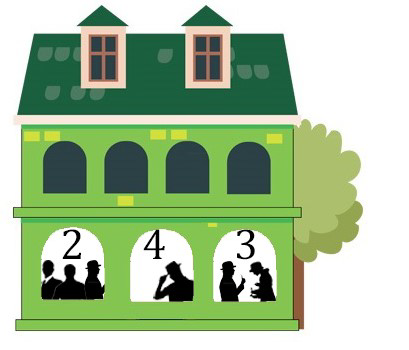Problems
In a row there are 2023 numbers. The first number is 1. It is known that each number, except the first and the last, is equal to the sum of two neighboring ones. Find the last number.
Are there such irrational numbers \(a\) and \(b\) so that \(a > 1\), \(b > 1\), and \(\lfloor a^m\rfloor\) is different from \(\lfloor b^n\rfloor\) for any natural numbers \(m\) and \(n\)?
Two players in turn paint the sides of an \(n\)-gon. The first one can paint the side that borders either zero or two colored sides, the second – the side that borders one painted side. The player who can not make a move loses. At what \(n\) can the second player win, no matter how the first player plays?
Welcome back! We hope you all had a great summer and now you are ready for the new school year full of fun problems in mathematics. We decided to start with warm-up topic called dissections, so today we will cut various shapes into more elaborate geometric figures in order to reassemble them into a different shape.
The meeting of the secret agents took place in the green house.

Considering the numbers in the windows of the green house, what
should be drawn in the empty frame?

Today we will practice to encrypt and decipher information using some
of the most common codes. Majority of the codes in use can be alphabetic
and numeric, namely one may want to encode a word, a phrase, or a
number, or just any string of symbols using either letters, or numbers,
or both. Some of the codes, however may use various other symbols to
encrypt the information. To solve some of the problems you will need the
correspondence between alphabet letters and numbers
0.85
@*26c@ A & B & C &
D &E & F &G &H &I &J &K &L
&M&N&O&P&Q&R&S&T&U&V&W&X&Y&Z
1 & 2 &
3&4&5&6&7&8&9&10&11&12&13&14&15&16&17&18&19&20&21&22&23&24&25&26
Find one way to encrypt letters of Latin alphabet as sequences of \(0\)s and \(1\)s, each letter corresponds to a sequence of five symbols.
Pinoccio keeps his Golden Key in the safe that is locked with a
numerical password. For secure storage of the Key he replaced some
digits in the password by letters (in such a way that different letters
substitute different digits). After replacement Pinoccio got the
password \(QUANTISED17\). Honest John
found out that:
• the number \(QUANTISED\) is divisible
by all integers less than 17, and
• the difference \(QUA-NTI\) is
divisible by \(7\).
Could he find the password?
Using the representation of Latin alphabet as sequences of \(0\)s and \(1\)s five symbols long, encrypt your first and last name.
Decipher the quote from Philip Pullmans "His Dark Materials":
Erh csy wlepp orsa xli xvyxl, erh xli xvyxl wlepp qeoi csy jvii.
The same letters correspond to the same in the phrase, different letters
correspond to different. We know that no original letters stayed in
place, meaning that in places of e,r,h there was surely something
else.